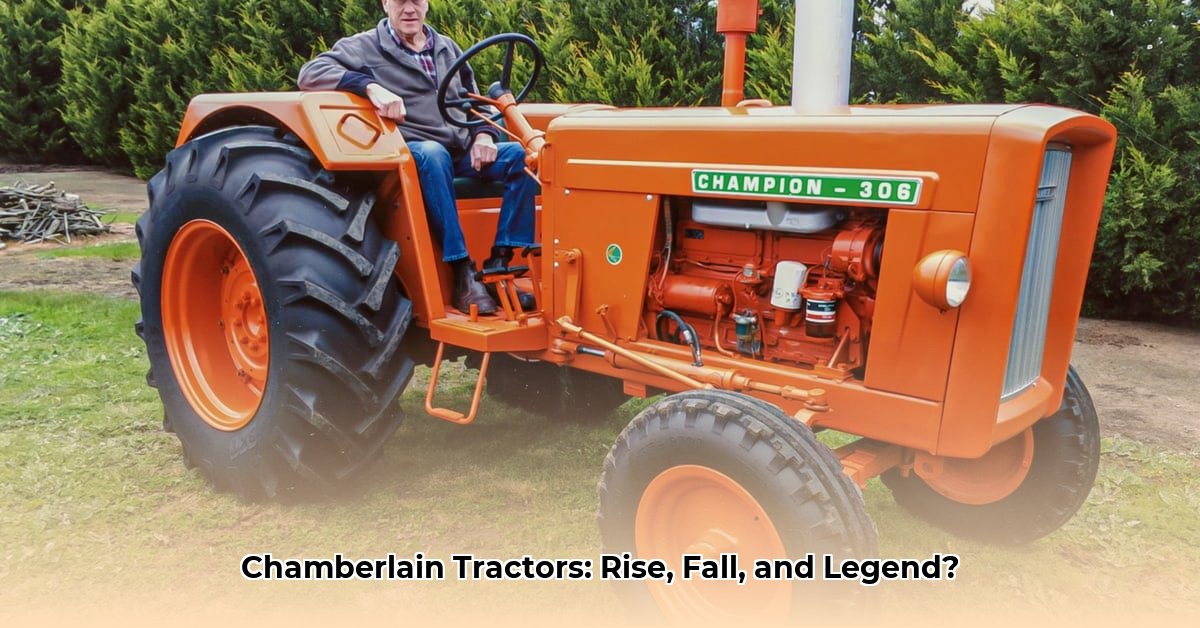
Chamberlain Tractor: Aussie Farm Legend
Imagine the sun beating down on the vast Australian outback. A sturdy Chamberlain tractor rumbles across the parched earth, its engine a powerful heartbeat against the quiet landscape. This isn't just a tractor; it's a symbol of Aussie ingenuity, a testament to a bygone era of agricultural innovation. The Chamberlain story is one of remarkable growth, surprising success, and ultimately, a bittersweet decline – a classic Aussie underdog tale. Its journey began with the vision of a single mechanic, who dreamed of building a tractor perfectly suited to the harsh realities of Australian farming. The early Chamberlain models, particularly the legendary 40K, quickly became indispensable tools, earning a reputation for unshakeable reliability and hard-nosed durability on farms across the nation. The clever switch to powerful diesel engines further cemented their status as workhorses of Australian agriculture. This unwavering dedication to quality is exemplified by the famous "Tail End Charlie" publicity stunt, a bold display of confidence that quickly became a piece of Australian folklore.
Did you know that the unique design features of early Chamberlain tractors played a pivotal role in their early success? The twin-cylinder engines, for example, proved perfectly suited to the Australian conditions. For more on vintage tractor history, check out this helpful resource.
Golden Years: Government Backing and Aussie Innovation
Government support played a crucial role in Chamberlain's initial triumph. This wasn't simply a handout; it came with challenges. The company’s unwavering focus on the local Australian market, while initially a winning strategy, proved to be a double-edged sword. As globalization swept through the agricultural industry, the sturdy Chamberlain faced increasing competition from massive international players. Chamberlain’s unique design features, while perfect for Australia, didn't always appeal to international markets. Did this unwavering commitment to their original design philosophy ultimately limit their ability to adapt and compete? It's a question that continues to spark debate.
"Chamberlain tractors were built to last," says Dr. Amelia Hayes, Agricultural Historian at the University of Melbourne. "Their resilience mirrored the spirit of the Australian farmer."
Sunset on the Plains: Market Shifts and a Legacy Forged in Steel
By the 1980s, market trends were shifting dramatically. In 1986, the factory gates closed for the final time, marking the end of an era. The iconic Chamberlain tractor fell silent. However, the remarkable legacy of the Chamberlain tractor persists. Its enduring appeal extends beyond the machines themselves—many carefully restored and cherished by dedicated owners—and resonates deeply within Australian engineering and agricultural heritage. The ultimate acquisition by John Deere speaks volumes about the international recognition of the brand and its design quality. Even today, these machines are regularly seen at heritage tractor pulls, drawing admiring crowds. A large-scale sculpture even celebrates the iconic tractor's place in Australian culture.
How many Chamberlain tractors were produced throughout their history? Precise figures are still being researched, but early estimates point to a significant number, reflecting their widespread use across Australia.
The Future is Now: Preserving a Piece of History
What does the future hold for these magnificent machines? The enduring fascination with Chamberlain tractors suggests a bright future within the heritage sector. A passionate community of collectors and enthusiasts is actively involved in restoration projects, keeping these agricultural icons alive. Museums and heritage organizations are showcasing these remarkable pieces of history. Could we see a return of Chamberlain tractors to the fields? It's a possibility some are exploring. However, the immediate future looks focused on preservation, ensuring that the story of the Chamberlain continues to inspire and captivate.
Actionable Steps for Preserving the Chamberlain Legacy
Here are key steps for various stakeholders:
Vintage Tractor Enthusiasts: Organize restoration workshops, create online communities, and participate in shows. Long-term, develop a national registry, build a comprehensive digital archive, and establish regional clubs.
Museums & Heritage Organizations: Acquire significant models and curate compelling exhibitions. Long-term, develop in-depth oral histories, expand displays, and build public-private partnerships.
Agricultural Machinery Dealers: Create specialized parts sourcing networks and offer restoration services. Long-term, invest in training and expand service offerings for this niche market.
Researchers & Historians: Analyze market data, publish research findings, and explore the socioeconomic impact. Long-term, conduct further research on production numbers, compare Chamberlain to global competitors, and explore the impact of government policies.
How to Restore a Vintage Chamberlain Tractor Engine
Restoring a Chamberlain engine is a labor of love, demanding dedication and expertise.
Assessing the Damage: A Crucial First Step
Before starting the restoration, a thorough assessment is critical. Disassemble key components and examine each part for wear, cracks, and corrosion. Document everything—photos, notes, sketches—to guide your restoration.
Sourcing Parts: The Treasure Hunt
Finding parts can be challenging. Online forums, specialist parts suppliers, and fellow enthusiasts are valuable resources. Rebuild kits, when available, are a good starting point. However, for rarer models, fabrication might be necessary.
The Restoration Process: A Step-by-Step Guide
- Disassembly: Meticulously disassemble the engine, carefully labeling and storing each component. Clean thoroughly.
- Inspection and Assessment: Inspect each component for wear and damage. Determine what needs replacing or repairing.
- Parts Sourcing and Fabrication: Source replacement parts or fabricate missing components.
- Cleaning and Repair: Clean, repair, or replace damaged parts.
- Reassembly: Carefully reassemble the engine.
- Testing: Thoroughly test the restored engine.
Cost-Benefit Analysis: Rebuild vs. Replacement
The decision to rebuild or replace hinges on several factors: model rarity, damage extent, parts availability, and cost. A rebuild is often more cost-effective for common models, but restoring a rare engine can be substantially more expensive.
The Chamberlain tractor story is a continuous narrative, shaped by the efforts of enthusiasts, historians, and organizations dedicated to preserving Australian agricultural heritage. The roaring engine may be silent, but the legend lives on.